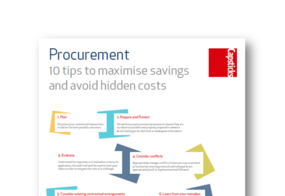Procurement – our top 10 tips to maximise savings and avoid hidden costs
05/11/18There's been a lot of reports in the press about the great work being done by emergency services across the country to realise some key procurement savings and efficiencies.
Earlier this year, the Home Office reported on Police Forces saving £273 million in three years on equipment costs. In July, the National Fire Chief’s Council’s reported on the success of their recent “procurement survey” and the savings made across fire authorities. Lord Carter’s recent report also stresses the further work that our Ambulance Trusts can be doing to meet some of these efficiency challenges and to drive further innovation through the way in which goods and services are procured. What’s evident with much of this success, is that it focuses on the real tangible cost reduction - whether through leveraging greater buying power through collaborative procurement or otherwise.
From our experience in working with blue light organisations, we can see that there is still much to be achieved from some of the “easy wins”. We’ve pulled together our top 10 tips to help you maximise those savings: See our infographic here.
Our top 10 tips:
- Plan - Structuring your commercial transactions to deliver the best possible outcomes. Be clear about what it is you want to achieve and ensure your procurement process and documentation enables the delivery of your intended outcomes. Testing where you are and where you want to be with legal advisers can help to ensure you get to the intended destination.
- Prepare and Protect - Streamline your procurement processes to ensure they are as robust as possible and properly prepared in advance. Provide bidders with sufficient information so that they are able to make an informed bid that is properly costed which may help to mitigate challenges for deficiencies/inadequate information at a later stage.
- Evaluate - Understand the importance of evaluation criteria, its application, the audit trail and the need to train your team in order to mitigate the risks of a challenge and ensure your documentation is clear, transparent and key decisions clearly justified. Similar to e mails, this documentation may have to be disclosed as part of disclosure/FOIA request and so as much care should be taken with this documentation as any other.
- Consider conflicts - Appropriately manage conflict of interests in procurement processes by ensuring protocols and safeguards are appropriately built in, implemented and followed.
- Consider existing contractual arrangements – Do you have alignment around when one contract ends and a new one starts? Ensure you are appropriately managing that transition. Where possible plan in advance to reduce the risk of being exposed to challenges through direct awards for unplanned extensions and variations. Really consider what constitutes a genuine emergency (not simply because you have ran out of time to plan!), or a real pilot arrangement, when to legitimately and justifiably use a VEAT notice, be confident of when you are dealing with an excluded land transaction or a development agreement that may well constitute a public contract for services and/or works. These are some of the more common areas and realities we know clients need to manage on a regular basis.
- Learn from you past mistakes - Don’t just breathe a sigh of relief that there was a lucky escape from challenge on this occasion. Take steps to minimise the likelihood of those circumstances arising again and prevent future mistakes. Ensure you adopt an open loop of feedback for all procurement projects you undertake and strive for continuous improvement.
- Improve benefits post procurement - Once the procurement has concluded, ensure your teams continue to appropriately performance and contract manage suppliers to ensure you are realising all of the benefits intended. Hold your service providers to account on all of their “added value” offerings.
- Upskill your internal team - Ensure they receive knowledge transfer from external experts and understand the contracts and processes they are required to manage on a day to day basis
- Going beyond compliance - Even where you are accessing already compliant centrally procured framework arrangements and call-offs, or if another entity is hosting or leading, ensure you have thought about everything you need and may need to incorporate. Don’t just work from the assumption that someone else will have already covered all aspects.
- Challenge and Learn – Challenge yourself on all aspects of procurement and seek input and assistance from third party experts to ensure you are aware of some of the potential blind spots that may be lurking. Learn from previous projects and experience elsewhere.
At Capsticks we strive to ensure our clients are “one step ahead” in delivering their ambitions to ensure value for money and as a consequence, the best possible services for the public. Please do get in touch for a chat about how we may be able to work with your team to help deliver on some of the procurement savings that can still be realised.






